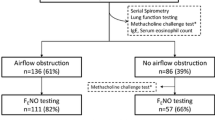Abstract
Objectives
To determine the utility of Fractional Exhaled Nitric Oxide (FENO) in the identification of uncontrolled asthma in children on therapy, and to identify its cut-off value for determining asthma control.
Methods
207 children (age 5–15 y) with physician-diagnosed asthma on therapy with at least 12 months follow up were enrolled. Spirometry and FENO measurements were performed. Asthma control was assessed as per GINA guidelines. Sensitivity and specificity of various cut-off values of FENO (15 ppb, 20 ppb, 25 ppb, 30 ppb) for identification of status of control of asthma were calculated.
Results
156 (75%) children had uncontrolled or partly controlled asthma and 51 children were assessed to have controlled asthma. Median (IQR) FENO in children with controlled and uncontrolled asthma was 16 (11–23) ppb and 13 (11–25) ppb, respectively (P=0.26). No FENO cut-off had a reasonable combination of sensitivity and specificity to discriminate between controlled and uncontrolled asthma.
Conclusion
FENO, in itself, does not have good discriminatory value in assessment of controlled and uncontrolled asthma in children on asthma therapy.
Similar content being viewed by others
References
From the Global Strategy for Asthma Management and Prevention, Global Initiative for Asthma (GINA) 2015. Available from: http://www.ginasthma.org/. Accessed 13.10.2015
Dweik RA, Boggs PB, Erzurum SC, Irvin CG, Leigh MW, Lundberg JO, et al., on behalf of ATS Committee on Interpretation of Exhaled Nitric Oxide (FENO) for Clinical Application. An official ATS Clinical Practice Guideline: Interpretation of Exhaled Nitric Oxide Levels (FENO) for clinical applications. Am J Respir Crit Care Med 2011;184:602–15.
Kharitonov SA, Donnelly LE, Montuschi P, Corradi M, Collins JV, Barnes PJ. Dose-dependent onset and cessation of action of inhaled budesonide on exhaled nitric oxide and symptoms in mild asthma. Thorax. 2002;57:889–96.
Jones SL, Herbison P, Cowan JO, Flannery EM, Hancox RJ, McLachlan CR, et al. Exhaled NO and assessment of anti-inflammatory effects of inhaled steroid: dose-response relationship. Eur Respir J. 2002;20:601–8.
Jatakanon A, Lim S, Kharitonov SA, Chung KF, Barnes PJ. Correlation between exhaled nitric oxide, sputum eosinophils, and methacholine responsiveness in patients with mild asthma. Thorax. 1998;53:91–5.
Visitsunthorn N, Prottasan P, Jirapongsananuruk O, Maneechotesuwan K. Is fractional exhaled nitric oxide (FeNO) associated with asthma control in children? Asian Pac J Allergy Immunol. 2014;32:218–25.
Khalili B, Boggs PB, Shi R, Bahna SL. Discrepancy between clinical asthma control assessment tools and fractional exhaled nitric oxide. Ann Allergy Asthma Immunol. 2008;101:124–9.
Waibel V, Ulmer H, Horak E. Assessing asthma control: symptom scores, GINA levels of asthma control, lung function, and exhaled nitric oxide. Pediatr Pulmonol. 2012;47:113–8.
Raj D, Lodha R, Mukherjee A, Sethi T, Agrawal A, Kabra WHAT IS ALREADY KNOWN? • Asthma control can be objectively documented with Fractional exhaled nitric oxide (FENO) values WHAT THIS STUDY ADDS? • FENO values do not have discriminatory value for identification of asthma control using GINA guidelines for assessment of asthma. SK. Fractional exhaled nitric oxide in children with acute exacerbation of asthma. Indian Pediatr. 2014;51:105–11.
Miller MR, Hankinson J, Brusasco V, Burgos F, Casaburi R, Coates A, et al. Standardisation of spirometry. Eur Respir J. 2005;26:319–38.
Volbeda F, Broekema M, Lodewijk ME, Hylkema MN, Reddel HK, Timens W, et al. Clinical control of asthma associates with measures of airway inflammation. Thorax. 2013;68:19–24.
Ozier A, Girodet PO, Bara I, Tunon de Lara JM, Marthan R, Berger P. Control maintenance can be predicted by exhaled NO monitoring in asthmatic patients. Respir Med. 2011;105:989–96.
Delgado-Corcoran C, Kissoon N, Murphy SP, Duckworth LJ. Exhaled nitric oxide reflects asthma severity and asthma control. Pediatr Crit Care Med. 2004;5:48–52.
Meyts I, Proesmans M, De Boeck K. Exhaled nitric oxide corresponds with office evaluation of asthma control. Pediatr Pulmonol. 2003;36:283–9.
Sippel JM, Holden WE, Tilles SA, O’Hollaren M, Cook J, Thukkani N, et al. Exhaled nitric oxide levels correlate with measures of disease control in asthma. J Allergy Clin Immunol. 2000;106:645–50.
Bernstein JA, Davis B, Alvarez-Puebla MJ, Nguyen D, Levin L, Olaguibel JM. Is exhaled nitric oxide a useful adjunctive test for assessing asthma? J Asthma. 2009;46:955–60.
Green RJ, Klein M, Becker P, Halkas A, Lewis H, Kitchin O, et al. Disagreement between common measures of asthma control in children. Chest. 2013;143:117–22.
Ito Y, Adachi Y, Itazawa T, Okabe Y, Adachi YS, Higuchi O, et al. Association between the results of the childhood asthma control test and objective parameters in asthmatic children. J Asthma. 2011;48:1076–80.
Vijverberg SJ, Koster ES, Koenderman L, Arets HG, van der Ent CK, Postma DS, et al. Exhaled NO is a poor marker of asthma control in children with a reported use of asthma medication: a pharmacy-based study. Pediatr Allergy Immunol. 2012;23:529–36.
Michils A, Baldassarre S, van Mvylam A. Exhaled nitric oxide and asthma control: A longitudinal study in unselected patients. Eur Respir J. 2008;31:539–46.
Yavuz ST, Civelek E, Sahiner UM, Buyuktiryaki AB, Tuncer A, Karabulut E, et al. Identifying uncontrolled asthma in children with the childhood asthma control test or exhaled nitric oxide measurement. Ann Allergy Asthma Immunol. 2012;109:36–40.
Author information
Authors and Affiliations
Corresponding author
Rights and permissions
About this article
Cite this article
Meena, R.K., Raj, D., Lodha, R. et al. Fractional exhaled nitric oxide for identification of uncontrolled asthma in children. Indian Pediatr 53, 307–310 (2016). https://doi.org/10.1007/s13312-016-0842-z
Received:
Revised:
Accepted:
Published:
Issue Date:
DOI: https://doi.org/10.1007/s13312-016-0842-z




